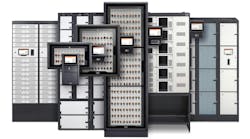Equinix Bets on Nuclear and Fuel Cells to Meet Exploding Data Center Energy Demand
Key Highlights
- Equinix has partnered with five alternative energy providers, including fuel cell and advanced nuclear reactor developers, to diversify and secure its power sources.
- The company currently operates 75 MW of fuel cell capacity and is constructing an additional 30 MW to support its data centers.
- Long-term plans include agreements with advanced reactor developers like Oklo, Radiant, ULC-Energy, and Stellaria, aiming to deploy scalable nuclear solutions by 2029-2035.
- These initiatives aim to enhance grid capacity, improve reliability, and promote sustainability, benefiting local communities and supporting AI-driven data center growth.
- Equinix's approach exemplifies industry leadership by balancing immediate energy needs with future scalability through innovative, next-generation technologies.
Equinix is expanding its energy strategy with a series of new partnerships aimed at meeting the surging power demands of AI and high-performance computing. The company last week announced agreements with five alternative energy providers, including developers of advanced nuclear reactors and long-standing fuel cell partner Bloom Energy.
In addition to procuring new sources of generation, Equinix said it is collaborating with utilities on advanced transmission upgrades, new substations, and backup power infrastructure. While these efforts are designed to support its growing portfolio of AI-focused data centers, the company emphasized that the investments will also strengthen local grids and benefit surrounding communities.
The overarching goal: to expand grid capacity and ensure reliable, sustainable power through a mix of existing and next-generation technologies such as fuel cells, natural gas, and advanced nuclear projects.
Raouf Abdel, Executive Vice President of Global Operations at Equinix, framed the initiative this way:
Access to round-the-clock electricity is critical to support the infrastructure that powers everything from AI-driven drug discovery to cloud-based video streaming. As energy demand increases, we believe we have an opportunity and responsibility to support the development of reliable, sustainable, scalable energy infrastructure that can support our collective future. By working with our energy partners, we believe we can support the energy needs of our customers and communities around the world by helping to strengthen the grid and investing in new energy sources.
Powering AI: Fuel Cells Today, Nuclear Tomorrow
Equinix has signed a mix of letters of intent and deployment contracts with five alternative energy providers. The most immediate expansion comes from Bloom Energy, a long-term partner whose solid oxide fuel cells have powered Equinix sites for more than a decade.
Today, Equinix operates roughly 75 MW of fuel cell capacity across 19 IBX data centers in six states. Under a new contract, another 30 MW is already under construction.
“As the demand for power increases, we anticipate innovation in alternative energy technologies increasingly playing a key role in the availability of power going forward,” said David Rinard, Vice President of Energy Operations at Equinix. “Bloom’s fuel cells allow us to generate cleaner and reliable electricity onsite at our data centers in a cost-effective way. We’re proud to have continued to expand our relationship with Bloom over the last decade and helped lead the industry forward.”
Expanding Into Advanced Nuclear
Equinix is also looking ahead to nuclear power as part of its long-term strategy. In 2024, the company signed its first agreement with advanced reactor developer Oklo, securing a commitment for 500 MW of capacity. Oklo’s fast reactor technology is designed to convert nuclear waste into fuel, leveraging a proven, inherently safe design. The company has been steadily advancing toward deployment milestones and remains a cornerstone of Equinix’s nuclear strategy.
On August 14, Equinix broadened its nuclear commitments by adding three more next-generation reactor providers:
-
Radiant: Equinix has placed a preorder for 20 of Radiant’s Kaleidos microreactors. Roughly the size of a shipping container, these units are designed to replace diesel backup generators. They can be transported by truck, rail, sea, or air and deployed in a “plug-and-play” fashion with minimal site preparation—potentially going live in less than 48 hours. Designed for five or more years of operation before refueling, each unit has a service life of around 20 years through multiple factory refueling cycles.
-
ULC-Energy: The Amsterdam-based developer will use the Rolls-Royce Small Modular Reactor (SMR) to fulfill a 250 MW contract in the Netherlands. Rolls-Royce has been selected as the preferred bidder to deliver Great Britain’s first SMR, a 470 MW light-water design that is factory-built for speed and scalability. Each unit is about 10% the size of a traditional nuclear plant and designed for a 500-day build cycle, with the ability to add modules over time to meet rising demand.
-
Stellaria: Equinix has signed a pre-order agreement for 500 MW of power from Stellaria’s molten-salt, fast-neutron SMR, known as the Stellarium. Developed in France through a collaboration between the Commissariat à l'Énergie Atomique et aux Énergies Alternatives (CEA) and Schneider Electric, with backing from Technip Energies and Orano, Stellaria’s design breeds 100% of its liquid fissile fuel inside the reactor while recycling spent fuels and burning long-lived nuclear waste. The project aims to have a functional prototype by 2029 and commercial deployment by 2035, supported by French government funding under the France 2030 program.
Tomorrow Will Be Here Sooner Than You Think
The timelines for these small modular reactor projects underscore Equinix’s long-term approach. By locking in capacity years ahead of deployment, the company is positioning its digital infrastructure to be not only more powerful and efficient, but also available when and where customers need it most.
Ali Ruckteschler, Senior Vice President and Chief Procurement Officer at Equinix, put it this way:
The potential challenges to powering reliable and sustainable digital infrastructure are considerable. However, Equinix has always been at the forefront of energy innovation, signing the data center industry’s first agreement with an SMR provider and pioneering the use of fuel cells a decade ago. Powering AI infrastructure responsibly is a global priority. With Equinix’s operational expertise, trusted supply chain, and close partnerships with the U.S. and global governments and utilities, we are poised to deliver safe, secure and reliable AI solutions for our customers and the communities we serve.
A New Chapter in Data Center Energy Strategy
Equinix's strategic investments in advanced nuclear and fuel cell technologies mark a pivotal moment in the evolution of data center energy infrastructure. By proactively securing power sources like Oklo's fast reactors and Radiant's microreactors, Equinix is not merely adapting to the industry's growing energy demands but is actively shaping the future of sustainable, resilient power solutions.
This forward-thinking approach is mirrored across the tech sector. Google, for instance, has partnered with Kairos Power to develop small modular reactors (SMRs) in Tennessee, aiming to supply power to its data centers by 2030 . Similarly, Amazon has committed to deploying 5 gigawatts of nuclear energy through partnerships with Dominion Energy and X-energy, underscoring the industry's collective shift towards nuclear energy as a viable solution to meet escalating power needs .
The urgency of these initiatives is underscored by projections from the U.S. Department of Energy, which anticipates data center electricity demand could rise to 6.7%–12% of total U.S. production by 2028, up from 4.4% in 2023. This surge, primarily driven by AI technologies, is straining existing grid infrastructure and prompting both public and private sectors to explore innovative solutions.
Equinix's approach, i.e. investing in both immediate and long-term energy solutions, sets a precedent for the industry. By integrating fuel cells for near-term needs and committing to advanced nuclear projects for future scalability, Equinix exemplifies a balanced strategy that addresses current challenges while preparing for future demands.
As the industry moves forward, the collaboration between data center operators, energy providers, and policymakers will be crucial. The path to a sustainable, resilient energy future for data centers lies in continued innovation, strategic partnerships, and a shared commitment to meeting the digital economy's power needs responsibly.
At Data Center Frontier, we talk the industry talk and walk the industry walk. In that spirit, DCF Staff members may occasionally use AI tools to assist with content. Elements of this article were created with help from OpenAI's GPT-5.
Keep pace with the fast-moving world of data centers and cloud computing by connecting with Data Center Frontier on LinkedIn, following us on X/Twitter and Facebook, as well as on BlueSky, and signing up for our weekly newsletters using the form below.
About the Author

David Chernicoff
Matt Vincent
A B2B technology journalist and editor with more than two decades of experience, Matt Vincent is Editor in Chief of Data Center Frontier.



